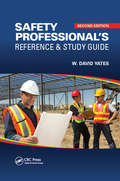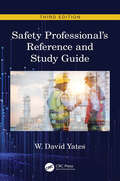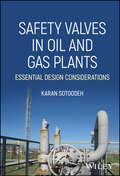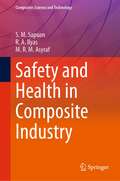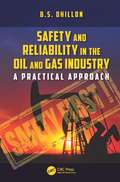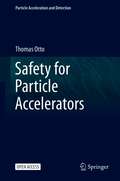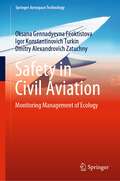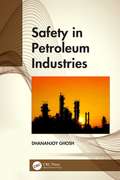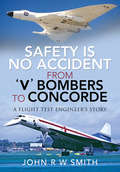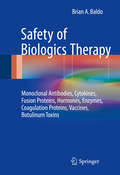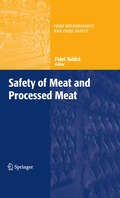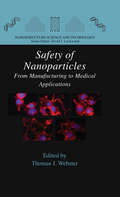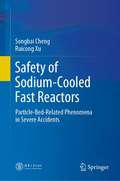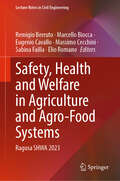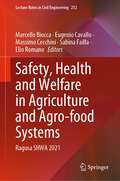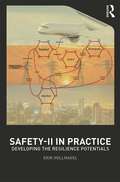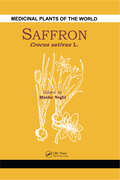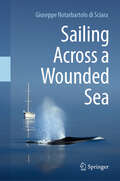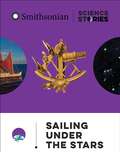- Table View
- List View
Safety Professional's Reference and Study Guide
by W. David YatesWhile there are numerous technical resources available, often you have to search through a plethora of them to find the information you use on a daily basis. And maintaining a library suitable for a comprehensive practice can become quite costly. The new edition of a bestseller, Safety Professional's Reference and Study Guide, Second Edition provides a single-source reference that contains all the information required to handle the day-to-day tasks of a practicing industrial hygienist. New Chapters in the Second Edition cover: Behavior-based safety programs Safety auditing procedures and techniques Environmental management Measuring health and safety performance OSHA’s laboratory safety standard Process safety management standard BCSPs Code of Ethics The book provides a quick desk reference as well as a resource for preparations for the Associate Safety Professional (ASP), Certified Safety Professional (CSP), Occupational Health and Safety Technologist (OHST), and the Construction Health and Safety Technologist (CHST) examinations. A collection of information drawn from textbooks, journals, and the author’s more than 25 years of experience, the reference provides, as the title implies, not just a study guide but a reference that has staying power on your library shelf.
Safety Professional's Reference and Study Guide, Third Edition
by W. David YatesThis new edition serves both as a reference guide for the experienced professional and as a preparation source for those desiring certifications. It’s an invaluable resource and a must-have addition to every safety professional’s library. Safety Professional’s Reference and Study Guide, Third Edition, is written to serve as a useful reference tool for the experienced practicing safety professional, as well as a study guide for university students and those preparing for the Certified Safety Professional examination. It addresses major topics of the safety and health profession and includes the latest version of the Board of Certified Safety Professional (BCSP) reference sheet, a directory of resources and associations, as well as state and federal agency contact information. Additionally, this new edition offers new chapters and resources that will delight every reader. This book aids the prospective examination candidate and the practicing safety professional, by showing them, step-by-step, how to solve each question/formula listed on the BCSP examination and provide examples on how and when to utilize them.
Safety Valves in Oil and Gas Plants: Essential Design Considerations
by Karan SotoodehComprehensive approach to designing safety valves used in oil and gas plants, featuring case studies throughout the text Safety Valves in Oil and Gas Plants delivers a comprehensive overview of the various aspects of safety valves in the oil and gas industries, including their design and accessories. To help reinforce learning, case studies included throughout the text and multiple-choice questions and answers are included at the end of each chapter. Written by an industry veteran with extensive publishing and speaking experience, this book includes information on: Design details such as sizing and reaction forces, inspection, maintenance, codes and standards, and packing and preservationDaily industrial challenges regarding the resizing of existing pressure safety valves (PSVs) or the proper sizing of new PSVsProcess safety standards for all new operative installations or existing ones in the chemical industryCatalysts that can increase the pressure of fluids, including human error and equipment and component failureThe role of safety valves in protecting properties, the environment, and human life This is an excellent reference on the subject for engineers and advanced students in chemical and process engineering, mechanical engineering, piping and valve engineering, and safety and instrument engineering.
Safety and Health in Composite Industry (Composites Science and Technology)
by R.A. Ilyas S.M. Sapuan M.R.M. AsyrafThis book provides the latest developments on safety practices utilized in composite manufacturing facilities for students, workers, engineers, and other participants. It includes commentary from academic experts in the field who present cutting-edge research on advanced composite materials. Illustrations, figures, and tables are included in this book in order to make it easier for students, workers, engineers, and other participants to understand the contents of this book. The end user knows the safety and health that should be practiced in composite industry and their right in composite industry. Besides that, the composites industry players can upgrade their current safety system to the recommended practiced system. A lot of problems are solved by integrate the current system and advanced technology system from extensive research.
Safety and Reliability in the Oil and Gas Industry: A Practical Approach
by B.S. DhillonAn Insightful Guide to Avoiding Offshore Oil- and Gas-Industry Disaster Designing, constructing, operating, and maintaining offshore oil and gas industry equipment and systems can sometimes result in accidents, injuries, and other serious problems. Safety and Reliability in the Oil and Gas Industry: A Practical Approach focuses on oil and gas indus
Safety for Particle Accelerators (Particle Acceleration and Detection)
by Thomas OttoThe use of non-standard technologies such as superconductivity, cryogenics and radiofrequency pose challenges for the safe operation of accelerator facilities that cannot be addressed using only best practice from occupational safety in conventional industry. This book introduces readers to different occupational safety issues at accelerator facilities and is directed to managers, scientists, technical personnel and students working at current or future accelerator facilities. While the focus is on occupational safety – how to protect the people working at these facilities – the book also touches on “machine safety” – how to prevent accelerators from doing structural damage to themselves. This open access book offers a first introduction to safety at accelerator facilities. Presenting an overview of the safety-related aspects of the specific technologies employed in particle accelerators, it highlights the potential hazards at such facilities and current prevention and protection measures. It closes with a review of safety management and organization at accelerator facilities.
Safety in Civil Aviation: Monitoring Management of Ecology (Springer Aerospace Technology)
by Dmitry Alexandrovich Zatuchny Oksana Gennadyevna Feoktistova Igor Konstantinovich TurkinThis book presents a methodology for assessing environmental safety in civil aviation. The methodology allows the comparison of different technological processes and evaluates their impact on the environment. At the same time, the medical and demographic indicators for ecologically unfavorable territories are compared with similar indicators in the control (background) territories in the same climatic and geographical zones. This book contains methodological recommendations for the creation of the system for ecology safety in the organizational structures of civil aviation. This book is useful to a wide audience—students of aviation, lecturers, as well as specialists in the field of ecology and those involved in ensuring the necessary ecology requirements at aviation enterprises.
Safety in Medication Use
by Bryony Dean Franklin Mary P. TullyAn estimated 1 in 20 patients are admitted to the hospital due to problems with their medication and 1 in 100 hospitalized patients are harmed due to medication errors during their stay. The prescribing of medications is the most common health care intervention and medication safety is relevant to all health care professionals and patients, in all
Safety in Petroleum Industries
by Dhananjoy GhoshSafety in Petroleum Industries covers pertinent safety aspects and precautions to be taken for design, operation, maintenance, inspection and project constructions for petroleum industries, with an emphasis on petroleum refineries. Relevant practical knowledge and experience contributing to safe and sustained operation of the industry has been compiled with all necessary references. Identified areas where theoretical inputs are required have also been incorporated. Learning objectives for the petroleum industries have been identified and discussed in an organized manner based on author’s more than thirty-five years of experience in petroleum and chemical industries. Aimed at practicing engineers in upstream and downstream petroleum industries, this book: Covers safety tips for operation of petroleum industries Documents design codes, tools and practices including safe operating practices of different equipment and safety procedures in a single source Includes detailed safety procedures like HAZOP, Safety Audit, management safety review, and process safety management Contains dedicated chapters on Fire Fighting, and Industrial Hygiene and Ergonomics Discusses first-hand experienced examples and burning issues in the petroleum industry
Safety is No Accident—From 'V' Bombers to Concorde: A Flight Test Engineer's Story
by John R. SmithA behind-the-scenes look at the aeronautical engineers who keep the skies safe. Many are surprised to learn that flying is, statistically, the safest means of transportation. Even less well known is the crucial role that flight test observers and engineers play in ensuring that level of safety. In this book, one of them recounts his experience as an aeronautical engineer working in partnership with test pilots, painting a vivid portrait of his flight-testing career from the 1960s to early 1980s at Avro and the UK&’s Civil Aviation Authority (CAA). During the author&’s time at Avro, he flew on the development and certification test flights of the Avro 748, 748MF, Shackletons, Nimrod, and Handley-Page Victor tanker. In the CAA, his role turned to regulation, making flight test assessments of manufacturer&’s prototypes and production aircraft, to check compliance with the CAA&’s flight safety requirements. The scope ranged from single-engine light aircraft to large civil transport aircraft. It involved frequent visits to foreign manufacturers and also included his participation in the CAA&’s Concorde certification flight test program. Advancements in the understanding of aerodynamics and an increasingly professional approach to risk management improved safety, but flight testing still involves risk, and several of the author&’s close friends and colleagues died in flight test accidents during this period. It is because of the courage and expertise of such people that millions of flights now touch down safely each year.
Safety of Biologics Therapy
by Brian A. BaldoThis long overdue title provides a comprehensive, up-to-date, state-of-the art review of approved biologic therapies, with coverage of mechanisms of action, Indications for therapy, immunogenicity and a detailed examination of adverse effects and safety of the many and diverse therapeutic agents presented in a total of 13 chapters. It is predicted that by 2016, biologics will make up half of the world's 20 top-selling drugs and by 2018, biologic medicine sales will account for almost half of the world's 100 biggest selling drugs. Recombinant proteins dominate the growing list of the more than 200 approved biotherapeutic agents with targeted antibodies, fusion proteins and receptors; cytokines; hormones; enzymes; proteins involved in blood-clotting, homeostasis and thrombosis; vaccines; botulinum neurotoxins; and, more recently, biosimilar preparations, comprising the majority of approved biologics. Written with clinicians, other health care professionals, and researchers in mind, Safety of Biologics Therapy examines, in a single volume, the full range of issues surrounding the safety of approved biologic therapies. A good understanding of the risks and safety issues of modern biologics therapy is increasingly being demanded of all those connected with their development, handling, prescribing, administration and subsequent patient management. In addition to being of great value to clinicians in all branches of medicine, and to nurses, pharmacists and researchers, this book will prove invaluable for students taking undergraduate and graduate courses in the above disciplines and in the biomedical sciences.
Safety of Meat and Processed Meat
by Fidel ToldráSafety of Meat and Processed Meat provides the reader with the recent developments in the safety of meat and processed meat, from the abattoir along the processing chain to the final product. To achieve this goal, the editor uses five approaches. The first part deals with the main biological contaminants like pathogen microorganisms, specially E. coli and L. monocytogenes, toxins and biogenic amines that can be present either in meat or its derived products. The second part focuses on main technologies for meat decontamination as well as developments like active packaging or bioprotective cultures to extend the shelf life. The third part presents non-biological contaminants and residues in meat and meat products including nitrosamines, PAH, veterinary drugs and environmental compounds. The fourth part discusses current methodologies for the detection of microorganisms, its toxins, veterinary drugs, environmental contaminants and GMOs, and the final part deals with predictive models, risk assessment, regulations on meat safety, consumer perception, and other recent trends in the field. This book is written by distinguished international contributors with excellent experience and reputation. In addition, brings together advances in different safety approaches.
Safety of Nanomaterials along Their Lifecycle: Release, Exposure, and Human Hazards
by Wendel Wohlleben Thomas A. J. Kuhlbusch Claus-Michael Lehr SchnekenburgerThe incorporation of nanomaterials into products can improve performance, efficiency, and durability in various fields ranging from construction, energy management, catalysis, microelectronics, plastics, coatings, and paints to consumer articles such as foods and cosmetics. But innovation never comes at zero risk. The potential hazards resulting fr
Safety of Nanoparticles
by Thomas J. WebsterIn spite of the potential use of nanomaterials as tissue engineering devices, implants, biosensors, drug delivery devices, etc., there has yet to be a compilation of the risks associated with the in vivo use of nanomaterials. There are numerous and well-known risks because of the size of nanoparticles. For example, nanoparticles can cross cell membranes and enter the cytoplasm undetected. The aim of this book is to provide one of the first (if not the first) detailed views of how cells and tissues in the body deal with nanoparticles. This is important not only for implantable devices, but also for the manufacturing of nanophase materials when particles can be inhaled or enter the body through the skin. Only by compiling research at the intersection of nanoparticles and biological processes can we determine if nanophase materials are safe to be manufactured, handled, and/or implanted for various medical applications.
Safety of Sodium-Cooled Fast Reactors: Particle-Bed-Related Phenomena in Severe Accidents
by Songbai Cheng Ruicong XuThis book highlights the advances and trends in the safety analysis of sodium-cooled fast reactors, especially from the perspective of particle bed-related phenomena during core disruptive accidents. A sodium-cooled fast reactor (SFR) is an optimized candidate of the next-generation nuclear reactor systems. Its safety is a critical issue during its R&D process. The book elaborates on research progresses in particle bed-related phenomena in terms of the molten-pool mobility, the molten-pool sloshing motion, the debris bed formation behavior, and the debris bed self-leveling behavior. The book serves as a good reference for researchers, professionals, and postgraduate students interested in sodium-cooled fast reactors. Knowledge provided is also useful for those who are engaging in severe accident analysis for lead-cooled fast reactors and light water reactors.
Safety, Health and Welfare in Agriculture and Agro-Food Systems: Ragusa SHWA 2023 (Lecture Notes in Civil Engineering #521)
by Marcello Biocca Eugenio Cavallo Massimo Cecchini Sabina Failla Elio Romano Remigio BerrutoThis book gathers the latest advances, innovations, and applications in the fields of agricultural biotechnology, agro-food systems and forestry, as presented by leading international researchers and engineers at the 7th International Conference on Safety, Health and Welfare in Agriculture and Agro-food Systems (SHWA), held in Ragusa, Italy, on September 6–9, 2023. The papers cover a range of topics such as agricultural assistive technologies, machine milking, animal welfare, sustainable livestock farming, work organization and logistic in agro-food supply chain, agricultural instrumentation and equipment, safety and health in building, agriculture 4.0, automation, occupational health, precision farming, effect of landscapes on human health, environmental safety, rural health, agricultural machinery, ROPS, augmented reality and IoT, cyber security. The contributions included in the book were selected by means of a rigorous peer-review process and offer an extensive and multidisciplinary overview of interesting solutions in the field of sustainable agriculture.
Safety, Health and Welfare in Agriculture and Agro-food Systems: Ragusa SHWA 2021 (Lecture Notes in Civil Engineering #252)
by Marcello Biocca Eugenio Cavallo Massimo Cecchini Sabina Failla Elio RomanoThis book gathers the latest advances, innovations and applications in the field of agricultural biotechnology, agro-food systems and forestry, as presented by leading international researchers and engineers at the 5th International Conference on Safety, Health and Welfare in Agriculture and Agro-food Systems (SHWA), held in Ragusa, Italy, on September 15-18, 2021. The papers cover a range of topics such as agricultural assistive technologies, machine milking, animal welfare, sustainable livestock farming, work organization and logistic in agro-food supply chain, agricultural instrumentation and equipment, safety and health in building, agriculture 4.0, automation, occupational health, precision farming, effect of landscapes on human health, environmental safety, rural health, agricultural machinery, ROPS, augmented reality and IoT, cyber security. The contributions included in the book were selected by means of a rigorous peer-review process, and offer an extensive and multidisciplinary overview of interesting solutions in the field of sustainable agriculture.
Safety-II in Practice: Developing the Resilience Potentials
by Erik HollnagelSafety-I is defined as the freedom from unacceptable harm. The purpose of traditional safety management is therefore to find ways to ensure this ‘freedom’. But as socio-technical systems steadily have become larger and less tractable, this has become harder to do. Resilience engineering pointed out from the very beginning that resilient performance - an organisation’s ability to function as required under expected and unexpected conditions alike – required more than the prevention of incidents and accidents. This developed into a new interpretation of safety (Safety-II) and consequently a new form of safety management. Safety-II changes safety management from protective safety and a focus on how things can go wrong, to productive safety and a focus on how things can and do go well. For Safety-II, the aim is not just the elimination of hazards and the prevention of failures and malfunctions but also how best to develop an organisation’s potentials for resilient performance – the way it responds, monitors, learns, and anticipates. That requires models and methods that go beyond the Safety-I toolbox. This book introduces a comprehensive approach for the management of Safety-II, called the Resilience Assessment Grid (RAG). It explains the principles of the RAG and how it can be used to develop the resilience potentials. The RAG provides four sets of diagnostic and formative questions that can be tailored to any organisation. The questions are based on the principles of resilience engineering and backed by practical experience from several domains. Safety-II in Practice is for both the safety professional and academic reader. For the professional, it presents a workable method (RAG) for the management of Safety-II, with a proven track record. For academic and student readers, the book is a concise and practical presentation of resilience engineering.
Saffron: Crocus sativus L. (Medicinal and Aromatic Plants - Industrial Profiles)
by Crocus Sativus LProviding a comprehensive and contemporary overview of the status of this particular genus, this book will be of interest to all those concerned with the study and uses of spices, medicinal and aromatic plants.
Sage: The Genus Salvia (Medicinal And Aromatic Plants - Industrial Profiles Ser. #Vol. 14)
by Spiridon E. KintziosSage, the genus Salvia is one of the most famous and used herbs in the world. This volume, containing twenty chapters written by the leading experts in the field, presents a comprehensive coverage on all aspects of Salvia. Topics covered include the presentation of the (approximately 400) most known Salvia species; the distribution of the genus; it
Said Nursi and Science in Islam: Character Building through Nursi’s Mana-i harfi (Routledge Studies in Religion)
by Necati AydinThis book examines how the prominent Muslim scholar Said Nursi developed an integrative approach to faith and science known as "the other indicative" (mana-i harfi) and explores how his aim to reconcile two academic disciplines, often at odds with one another, could be useful in an educational context. The book opens by examining Nursi’s evolving thought with regards to secular ideology and modern science. It then utilizes the mana-i harfi approach to address a number of issues, including truth and certainty, the relationship between knowledge and worldview formation, and the meaning of beings and life. Finally, it offers a seven-dimensional knowledge approach to derive meaning and build good character through understanding scientific knowledge in the mana-i harfi perspective. This book offers a unique perspective on one of recent Islam’s most influential figures, and also offers suggestions for teaching religion and science in a more nuanced way. It is, therefore, a great resource for scholars of Islam, religion and science, Middle East studies, and educational studies.
Sailing Across a Wounded Sea
by Giuseppe Notarbartolo di SciaraThe capacity of humans to destroy their environment is playing out like a Greek tragedy in the Mediterranean Sea. After having coexisted with a diversity of marine animals throughout their history, humans have broken the balance in recent decades, and the survival of countless marine creatures is now increasingly uncertain. However, unlike in classical tragedies, real-life entities are not necessarily doomed by their fate, and there must be hope to turn the tide in nature’s favour. Lack of concrete conservation action might be simply due to a lack of awareness: how can we feel sad about a loss if we don’t know what we are losing? “Sailing Across a Wounded Sea” is the story of an ideal journey around the Mediterranean to meet its non-human inhabitants, consisting of real episodes collected over half a century as the author observed real animals, exchanged views with a variety of contacts, and argued for such views in the policy arena. Encountering whales, dolphins,seals and rays in their habitat and on their terms will hopefully contribute to building up in readers a collective commitment to help secure a future for these species. A future where they are allowed to flourish as they were meant to - had humans never trod so heavily on the sea’s delicate ecological balance and the interwoven natural processes. Giuseppe Notarbartolo di Sciara has been involved for a lifetime in protecting marine biodiversity in various capacities – as a scientist, civil servant, advocate and sailor. Having studied in California and worked with whales, dolphins and sharks worldwide, he returned to the Mediterranean in 1985, keen on using his acquired tools to discover more about the ancient sea's natural history. Here, he described small but vibrant populations of fin and sperm whales, along with various species of dolphins, manta rays and the monk seal. At the same time, seeing the Mediterranean’s progressive degradation at the hands of humans, he felt a surge of rebellion against this squandering of natural values, and wished to raise awareness of the existence of these marine natural treasures and the risk of losing them. “Drawing from decades of first-hand experiences, in ‘Sailing Across a Wounded Sea’ Giuseppe Notarbartolo di Sciara offers a compelling narrative that interweaves the beauty of the Mediterranean Sea’s non-human inhabitants with the challenges they face due to human activity. As he reflects on his journey, the author underscores the imperative for collective action and the need for heightened awareness and proactive conservation measures to protect our oceans. ‘Sailing Across a Wounded Sea’ serves not only as a captivating voyage but also as a sobering call to responsibility. Join Giuseppe Notarbartolo di Sciara on this insightful expedition and discover the profound significance of preserving our marine ecosystems for future generations.” —Peter Thomson, United Nations Secretary General’s Special Envoy for the Ocean “The Mediterranean, the cradle of civilisation, is a sea steeped in history. From Apollon and Artemis to Pythagoras and Hercules, names in this book summon up images of civilisations past and lost. The greatest Greek philosopher of them all, Aristotle, is also regarded as the father of marine biodiversity, stemming from his research conducted on Lesbos Island. And yet this ancient world, familiar to so many, is under threat. In this book Notarbartolo di Sciara takes us on a modern-day odyssey through these waters, based on over 50 years of personal observations. He reminds us of the impact of the progressive footprint of human action and endeavour, which has spread out across the whole sea, changing, and depleting its beauty and splendour. His voyage paints a picture not just of what is at stake but also of the potential the future can hold if we all work together to give nature a breathing space, to allow it to restore and recover. In our modern world, where we h
Sailing Under the Stars: Below-Grade Reader (Smithsonian Science Stories)
by Smithsonian InstitutionGrade 5. 2019. 50 pages. Lexile range: 650-790L. Sailing Under the Stars Below-Grade Reader serves as an informational text resource that is incorporated into many lessons in the Smithsonian Science for the Classroom™ module How Can We Use the Sky to Navigate? Topics include: Star Gazing; Living in Microgravity; The Shadow Knows; Stories in the Stars; Doing the Beetle Dance; Lost and Found; and Polynesians and Potatoes.
